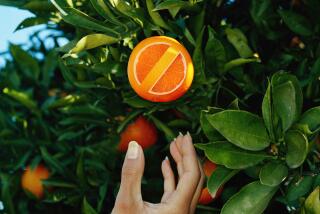Process Fruit to Avoid Spreading Medflies
- Share via
Fruit now ripening in Los Angeles area back yards presents a potential hazard. According to the media information office of the Cooperative Medfly Project, the most frequent way Medfly infestations spread is when contaminated produce is shared with friends and relatives outside a quarantined area.
Although a homeowner may not be able to see any evidence, Medfly eggs can still be present in fruit. In the early stages, the eggs are frequently visible only by a microscope.
“It’s imperative that those living in the quarantine zone process back yard fruit before it is moved or given away,” said project spokesman Larry Cooper. To make it safe, fruit must be canned, frozen, dried, baked or made into jam or jelly.
Consumers unable to use all their back yard fruit are urged to wrap the excess in a sturdy plastic bag, tie it shut and put it out for garbage pick-up. If the thought of destroying food concerns you, however, one alternative is to turn the fruit into leather.
Almost any type of fruit may be used, including back yard apricots, peaches, nectarines, plums and berries. Fruit leathers, also called fruit rolls, make excellent snacks.
Select ripe or over ripe fruit. Wash and remove the stones or pits (seeds of berries need not be removed). Peel, if desired.
Cut larger fruit into chunks and process enough in a blender to yield 1 1/4 cups puree (Step 1). Add one tablespoon lemon juice and honey to taste, then blend again (Step 2).
Pour the mixture onto a 15x10 1/2-inch jellyroll pan lined with parchment paper or plastic wrap (Step 3). Tilt the tray (Step 4) to distribute the mixture in an even layer.
Oven Drying
Heat the oven at the lowest setting (140 degrees). Place the tray in the oven, leaving the door cracked open. The leather will dry in four to five hours.
Dehydrator Drying
Place the tray in a dehydrator. Set the temperature control to 140 degrees. Dry four to five hours.
Sun Drying
Use this method only when the temperature is above 85 degrees and there is less than 60% relative humidity. Place the tray in direct sunlight or behind a pane of glass or Plexiglas to concentrate the heat. The leather should dry in two to three days. Cover or bring the tray indoors at night if the temperature varies more than 20 degrees or humidity rises.
When properly dried, leather will be sticky to the touch, but peel easily away from the parchment (Step 5). To store the leather, place a sheet of plastic wrap over the top and roll up both (Step 6), jellyroll fashion, into a loose cylinder. The plastic will prevent the leather from sticking together.
More to Read
Eat your way across L.A.
Get our weekly Tasting Notes newsletter for reviews, news and more.
You may occasionally receive promotional content from the Los Angeles Times.










